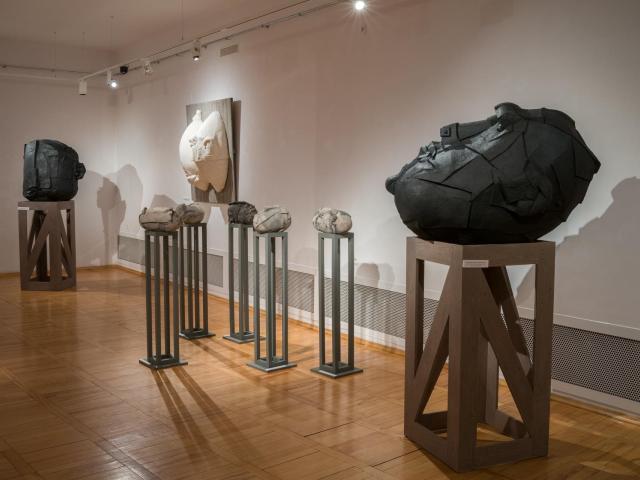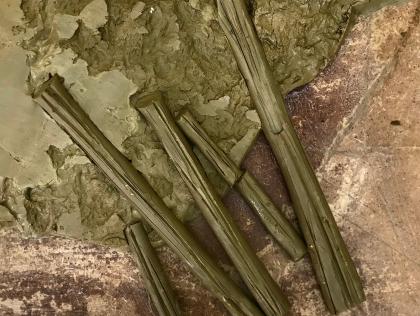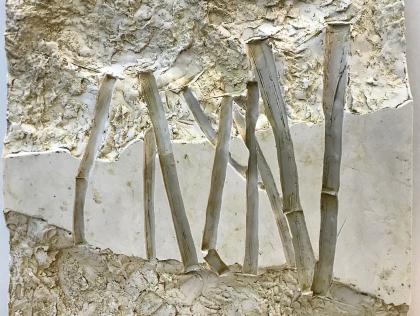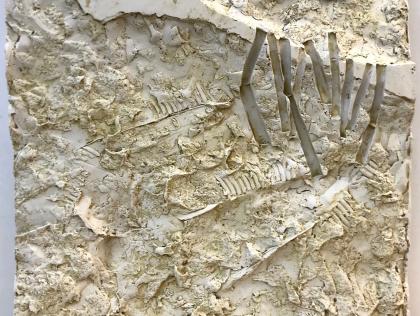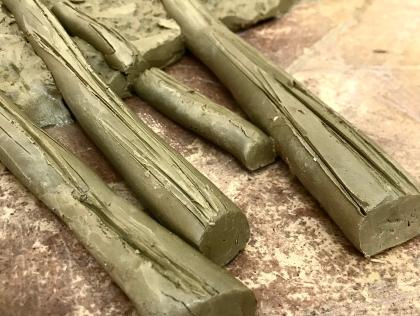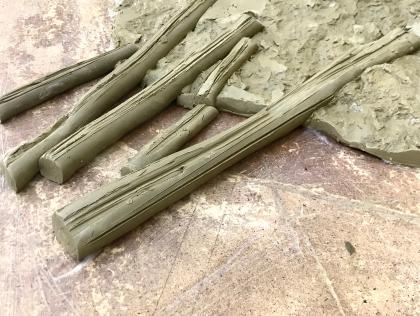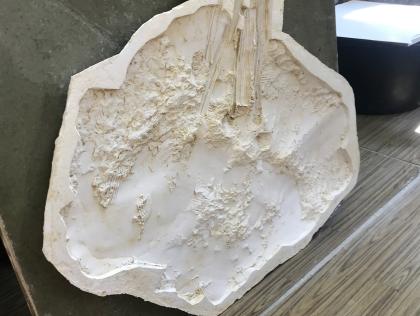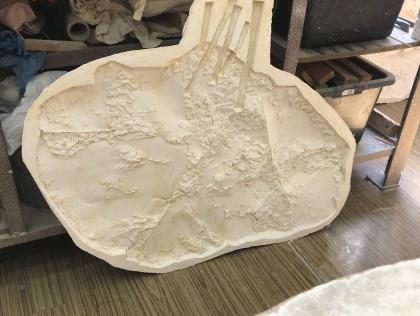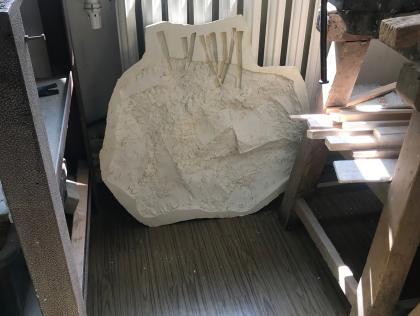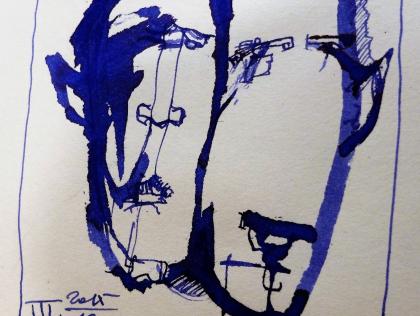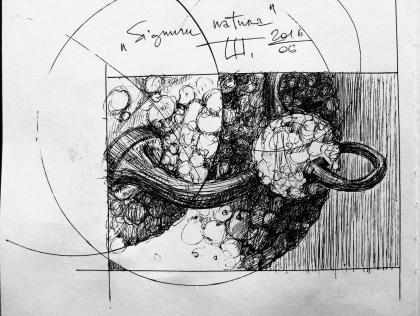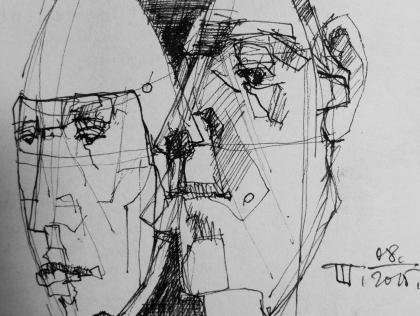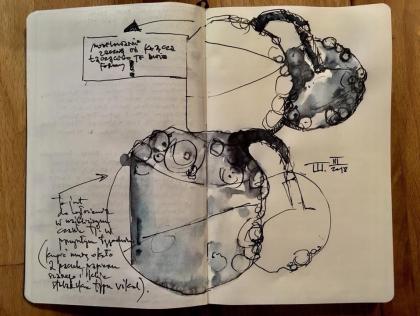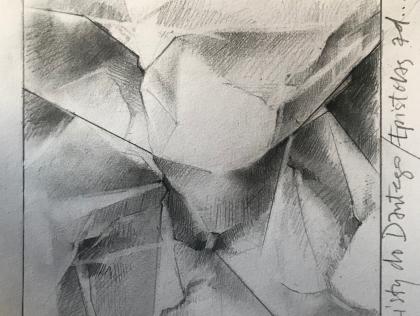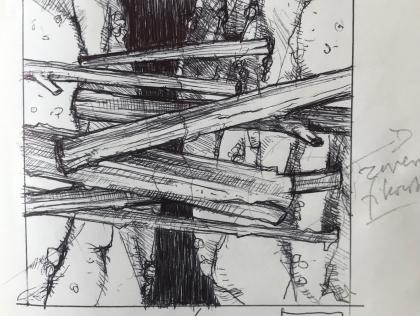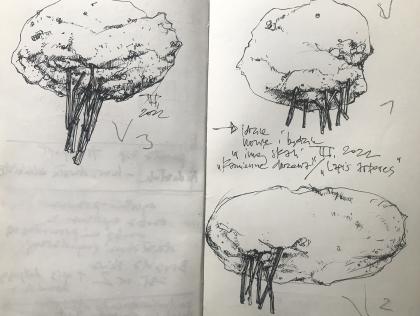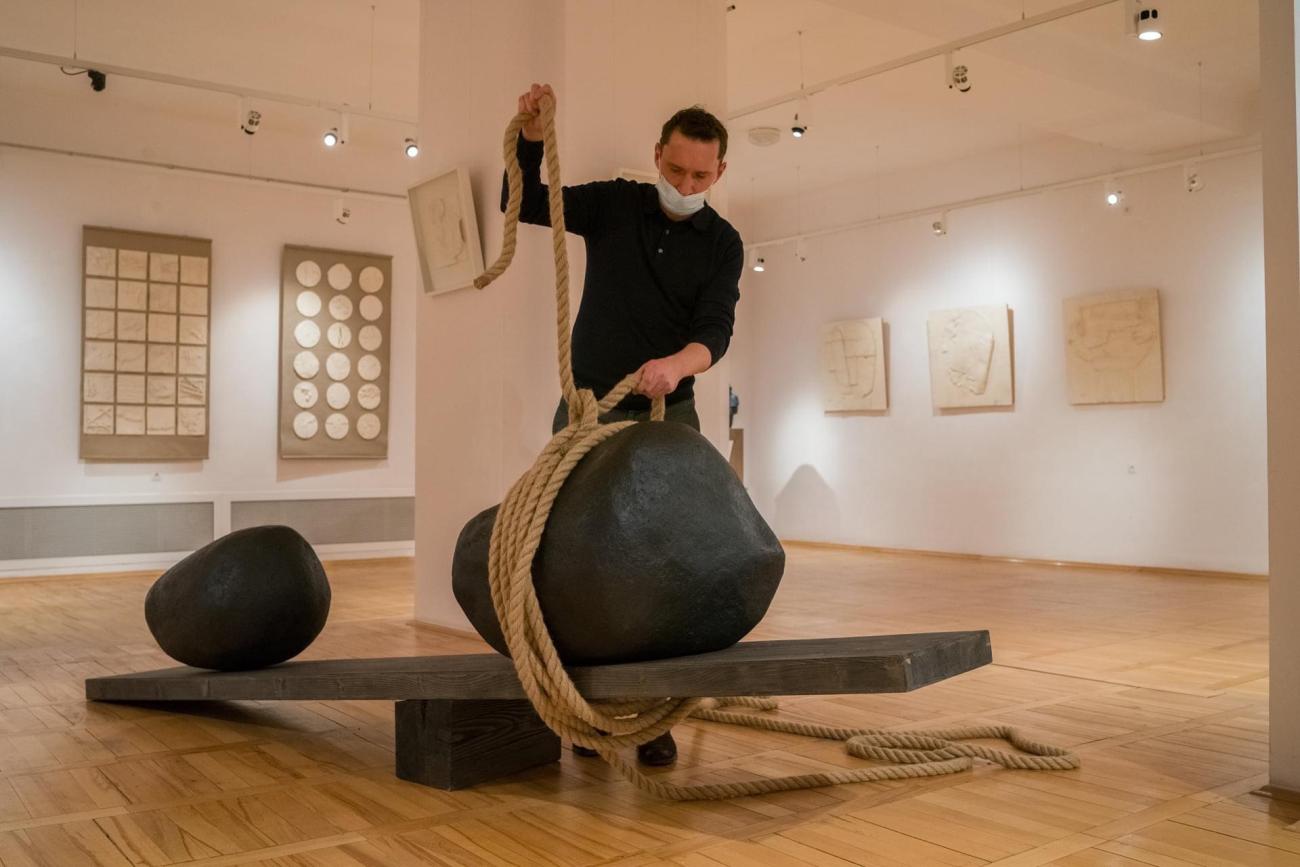
Tomasz Westrych — My sculptures often walk a fine line between the metaphor of the material and the illusion of its true weight.
You graduated from the Faculty of Sculpture at the Academy of Fine Arts in Kraków. What came before that? How did your journey with art begin? What led you to decide that this would be your life's path?
Yes… I graduated with a diploma from the Academy of Fine Arts in Kraków, at the Faculty of Sculpture, in 1996. Before that, like most of my colleagues—future ASP students—I was involved in education at a secondary school, or as we used to call it, "the art school."
It was precisely at the Art High School that I first began to consider forming a close relationship with something I was not yet fully aware of. However, thanks to the right teachers, whom I remember very warmly, I encountered a vibrant life and the passion they passed on, which slowly drew me towards art. The classes in fundamental subjects, thanks to these individuals, allowed me to discover my own way—coeducating my perception of the world with the interpretation of studio challenges.
At that time, I was experimenting with a little bit of everything, without being fully aware of what my favorite means of expression was. Having a broad perspective and not closing myself off in my own shell at a young age shaped me in a profound understanding of the visual arts. A key support was the specialized subject, which required discipline and knowledge—something I had to memorize by heart while working for grades. :)
How did you come to choose sculpture?
It wasn’t a straightforward decision—I carried it within me for a long time. I liked too many things to give up, for example, drawing or painting. Sculpture, as a subject in school, was more of a supplement to my main discipline, which was metalwork. My experience in the forge probably helped me later realize that I had a stronger inclination toward shaping tangible, spatial forms—objects that respond to the context of the area in which they are created.
Before that, however, I changed high schools and moved from the art school in Rzeszów to the one in Jarosław. There, I encountered a different approach to studying nature, with a greater focus on graphic design. My life and imagination became absorbed in the construction of letters and the proper use of typefaces. Hand-drawn sketches took on even greater importance, and designing posters with the right font became something that, I believe, still holds great significance for me to this day.
But returning to your question—why sculpture, and why I chose it. It was like a "to be or not to be" situation. At that time, after passing my high school exams, I had to quickly decide what to do next—otherwise, I faced mandatory military service. That, of course, wasn’t the only reason :), but for a young person, it was quite an important one.
We strategized on how to get into university, how to pass the entrance exams successfully, and how to ensure a satisfying outcome. Fewer candidates always applied to the Faculty of Sculpture, so I decided to focus my artistic efforts entirely in that direction and prepare my portfolio specifically for sculpture. Of course, it turned out to be much harder than I expected—though maybe that’s a story for another time. But in the end, I got in on my second attempt, and I was incredibly happy about it! :)
Shortly after graduating, you entered the competition for an assistant position in the Sculpture Studio at the Faculty of Interior Architecture. Was this an environment you were familiar with, or did you step into completely new territory?
That's true. Right after graduating, I took part in the competition for an assistant position in the First Sculpture Studio at the Department of General Art Subjects (I don’t remember the exact name anymore), which for many years now has been known as the Department of Fine Arts.
As a freshly graduated sculptor, I had already taken on various jobs during my studies, gaining experience not only in sculpture but also in conservation techniques, which I used in paid work restoring artworks. While working in conservation in a different region, some friends informed me about the announced competition. It turned out that, with little time and five transfers along the way, I managed to travel from the provinces to my scheduled interview—just in time for the last available slot, as I later found out.
I got the position. The final decision was made by the Faculty Council of Interior Architecture at the request of the department head, Professor Stanisław Hryń. My feelings after hearing the results could be summed up in one sentence—I was absolutely overjoyed, almost dizzy with happiness. But if you’re asking about familiarity with the environment, I knew almost nothing about it. Apart from a few people I had studied with, attended organized outdoor workshops with, or met at faculty parties (the so-called initiation balls for first-year students), I was stepping into unknown territory.
Yes… The Faculty of Interior Architecture was a completely new educational landscape for me. However, I gradually gained experience in a studio that trained and supported sculpture for future designers. I don’t want this to sound like false modesty, but whatever I do, I fully commit myself—even at the expense of my personal life—to achieve the best and most convincing results.
Sculpture itself is a field rich in techniques related to the chosen material. Which of them were your favorites? Which ones did you choose to work with?
That's a good question, and as usual... :) you don’t allow me to give an easy answer. It requires me to elaborate. We haven’t known each other for just a short time; our time together started much earlier, when you, as a student, also met various people along your path and visited their studios while they worked.
It was the same for me. The materials / sculptural media and their knowledge are gained throughout a lifetime, and even that may not be enough. During my studies, I had the choice of working in stone, wood, bronze, or ceramics. I took advantage of this opportunity, but in hindsight, I see that after graduation, we conduct our own studies and expand our own knowledge and skills.
Through experience, we can either choose or reject what suits us best. And execution is the best teacher. When working with stone or wood during conservation work, I was able to carry out restoration projects, and I noticed not only the possibilities but also the limitations of these techniques. It’s hard work, and in this context, it had nothing to do with choice; it was a necessity. And to avoid disliking it, as Wiesław Myśliwski once said about his literary work, one must find another dimension of personal satisfaction.
Since high school, I’ve been immersed in the stories of art historians, descriptions read in albums, or black-and-white photographs about painting, drawing, or sculpture.
What caught my attention were incomplete, as they were cross-sectional brochures from an exhibition of Adolf Ryszka. In the school library, they were not albums but postcards – signals from distant Poland, from a completely imagined world. It was a message with a content that stuck in my memory, focusing on the synthetic form of the oval and square of the plaque. Much later, when computer search engines worked wonders, I obtained the complete biography of the mentioned sculptor. By placing this valuable reference point on my creative path, I was able to build my own challenge. Therefore, after such a lengthy introduction, :) I’ll tell you that the most fitting work for me was casting in bronze.
I started making plaques, medals with the status of intimate expressions, but with a scope shaped with the intention of sounding like an orchestra. Hence, my work always tries to be realized in a series of representations… a group in which there are works that are exceptional to me and those that form the background value for the entire composition.
The question about techniques was raised because I know from well-informed sources :) that you are the author of your own technique, developed for your personal use, or even a technology. Could you explain what it is based on and what materials it relies on?
You see, in response to your next question, I should expand on what I mentioned earlier... :)
I’ll return to the series of works on various themes, created in relief with a diameter not exceeding 23 cm (of course, there are also other formats, such as square). I worked traditionally with clay and solidified the relief in a negative plaster mold. After some time, I stopped and, with some dread, realized that if I were to cast positive versions of these works in bronze... I’m not sure if, for financial reasons, I would be able to find a sponsor for my intentions. However, that didn’t stop me from continuing my creative search, so I kept working. At the same time, I started exploring my early works because time had passed, and my memory couldn’t help me recreate my modeling results. I’m not sure, and I don’t want to say for sure whether it's technique or technology; the difference depends on the formal solutions based on the shape of the future piece, with only small differences in technology. :) …not to extend the introduction, I’m trying to use paper in different forms as a material that I can apply in various ways for modeling. In my first attempts, I laminated/pressed/beat individual sheets of paper of different thicknesses with a large brush, directly in a dry negative plaster mold. Layer by layer, I built up thicknesses that I could leave to dry completely.
The paper pulp that I apply in the plaster negative or shape directly on the prepared mold is a mixture of different textures of paper, creating a uniform pulp. It has to be soaked in water for an appropriate amount of time, which softens the torn pieces of paper, so I can later mechanically grind different paper gradations to create the pulp.
When the papers have different colors, after shredding, I can dye them in the pulp with natural powder pigment. In my technological experiments, which somewhat deviate from traditional paper-making from cellulose (fiber plants), I had to add a binder made from a solution of polyvinyl acetate resin and water for my construction purposes. I think I’ll stop here, as this is not about providing a detailed recipe. :)
Where did the idea for this approach come from? Was it just a split-second decision to work this way, or was it the result of long-term work, research, and experiments?
I can confirm, in response to part of your question, that currently… it’s the result of technological exploration on various levels with different outcomes, because not everything we do on our creative path can be considered a personal success. Nevertheless, the search for solutions, which I am still open to, has lasted over 15 years. It is the outcome of long-term research not only into the structural properties of the material in which I ultimately create sculptures, but also a change over time and a reaction to how to convey the narrative in the composition of the work. Knowing which material I am using, I approach the execution differently and think about either laminating individual layers or, in another case, using paper pulp.
What led to the decision to choose this particular technique, especially one so unconventional for sculpture, which is typically associated with something "solid" and heavy (stone, wood, bronze castings)?
You know, the back end of a sculptor's studio is much more important than the space where the work is created. A large area is needed to store materials that you don’t always use at the moment. And when we think about a traditional workspace, for example, in stone or wood, I had to make a decision, as I didn’t have the conditions to work with materials typically used by sculptors. The decision is also shaped by many other factors, experiences, and reflections. I believe that an important factor is carrying a well-thought-out and conscious baggage through life. Without reflection on experiences, it’s better not to approach them or practice the profession of a creator. And, as you will likely agree, we are expected to break through stereotypical thinking about materials and mediums in art.
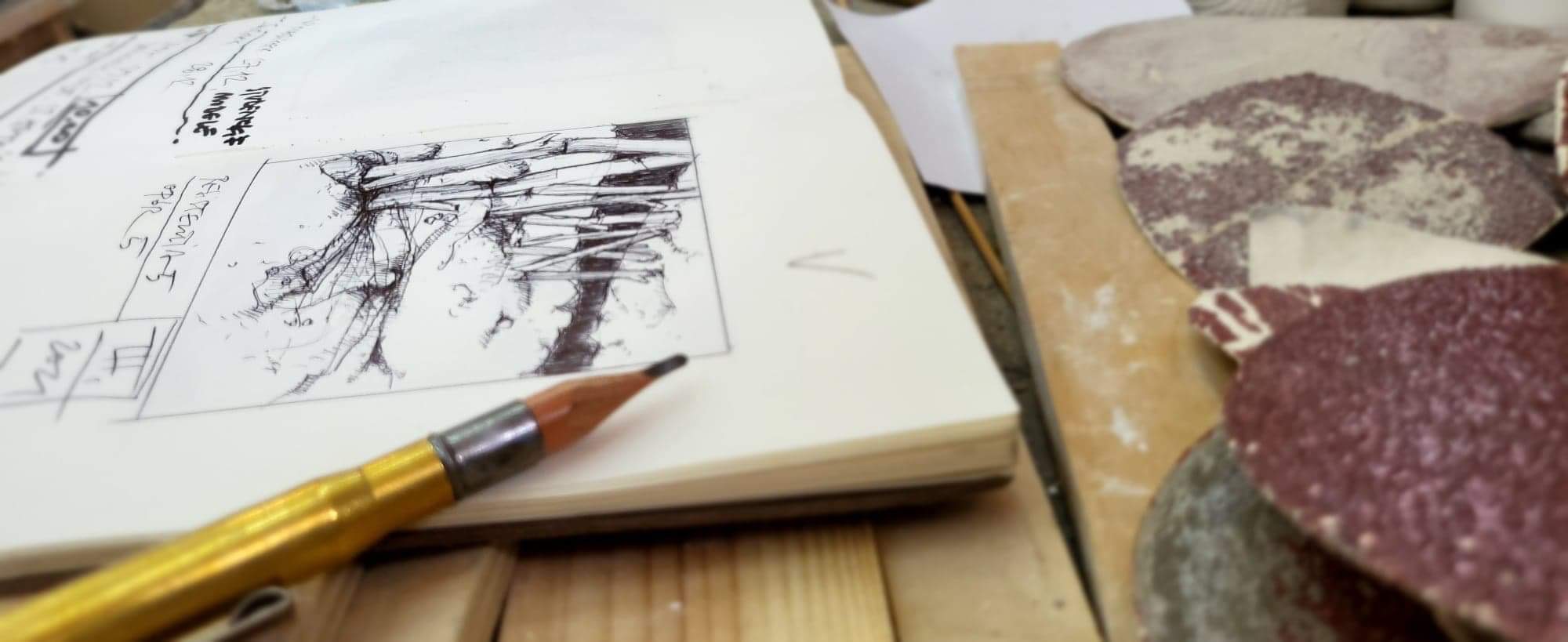
I remember my first encounter with your works and the surprise that came from the visual perception when confronted with their weight. What kind of reactions do you encounter when your works are received in this context?
Yes… the first encounter :) … it’s sometimes amusing, especially with people who think they know everything about life and art and want to show off their knowledge of the subject. I always politely listen to questions or comments, and I am open to them up to a certain point.
I like it when someone actually approaches closely and touches the sculpture’s material… I allow that. It’s an important interaction with the exhibition participants. Without this additional sensory experience, they might feel deceived. My sculptures often walk a fine line between the metaphor of the material and the illusion of its true weight.
So far, we’ve been talking about the material, but perhaps you could share what lies at the core of your creative process? What influences it? What inspires you?
As I mentioned earlier, we have the privilege of collecting experiences, selecting impressions from our surroundings, almost taking something in through our senses. I’ve always been inspired by nature, the world around us for many reasons, but primarily because we are part of it. It’s up to us, depending on our sensitivity, how we look at it and synthetically use it for our needs… artistic needs. In such moments, I am reminded of the words of Mieczysław Wejman, a painter and graphic artist, whose words have stuck with me and I now quote them as a maxim to others. There are three concepts that complement each other and stand at attention, guarding a certain creative attitude: intuition, knowledge, and experience.
I won’t expand on them, but anyone who applies their own thoughts to them will come to the conclusion that in creative searches, a person will always achieve personal satisfaction by applying fresh observations, reading with understanding, and working as practice.
I’ve noticed that you never part with your notebook, which is often filled with notes and sketches. Would you be willing to share a bit about its contents?
There are times when I don’t have it with me, and then I need to jot something down or sketch… so when it’s in my bag or backpack (even in the middle of the Vistula River), I feel more secure. :)
Of course, I’m joking a bit, but it’s a habit I developed back in art school… it was somewhat of a necessity at the time, but now it has become a privilege to have my notes, declarations, literary inspirations, nature sketches, or everyday life schedules with me. Sometimes I scan something from it and treat it as an electronic copy of a work.
I have a few of them (the notebooks), but I don’t treat them as something ambitious, like an illustration of a given statistical year – life often just flows... without mental gymnastics.
Your work with the materials you use in your art led to a collaboration with the Paper Museum in Duszniki-Zdrój. What does this collaboration involve?
A small correction – it is the Paper Museum, because here we are dealing not only with exhibits of various formats and functions, but also because paper has been continuously handmade there since the 16th century. In addition, as a cultural institution, the Museum has taken on the curation of a large department dedicated to paper art.
In 2016, I was looking for an exhibition space, which, as it turned out, was quite far from Kraków. It’s a bit of a pity because the Museum’s openness to collaboration could have offered opportunities for more frequent cooperation, not only for my private plans, but also, for example, for organizing workshops that could be interesting for students from our department.
As I mentioned earlier, I waited two years, and finally in 2018, my paper sculpture exhibition titled Signum Temporis was part of the Museum’s anniversary celebrations. During that time, I became a member of the prestigious International Association of Hand Papermakers and Paper Artists (IAPMA), and I realized there are more people like me, scattered all over the world.
Currently, the Museum's management and the curator of the Paper Art Department have proposed that I organize a triennale with the thematic organization of an artist residency cycle for those working with paper. The first edition will take place in September, and the artistic meeting will be held under the theme Re-Medium. Terra/Earth.
If everything goes as planned, the next editions will focus on the metaphors: Air and Water, and then, summarizing it all, we will present the outcome of the three residencies with an exhibition. According to the organizers, this will lay the foundation for the Triennale. We will also publish a catalog, so... a lot will be happening! :)
I know that you also infect your students with your material fascinations. How do they react to that? Judging by the works presented at the studio exhibitions, I assume positively?
You know, it’s not about infecting them, it’s more of an irresistible proposal. :)
I try to show the students a form of work that they haven’t encountered before. Of course, one might say they haven’t encountered plaster casts either. Most of the students coming to us haven’t had sculpture classes in secondary school, and our exam profile doesn’t include sculptural skills. Instead, it’s more about understanding spatial relationships closely tied to the object’s position relative to a measured surface.
The advantage of working in education is that most students want to learn something new. That’s why we (together with Professor Hryń) try to spark a passion in them, not force an answer to a set topic. I’m convinced that we’re succeeding. The process is difficult, but we try to guide them toward something that’s a result of their individual ideas and our corrections. On top of that, there’s the opportunity to use paper or paper pulp, which is an invaluable material and technological experience for the students.
Studies at the Faculty of Interior Architecture have their own specifics. Do you notice a difference between the students from the department you come from and the students of WAW?
The difference you mentioned does exist, but it is becoming less noticeable as times change, and the level of students in each year fluctuates. The most important thing is that there is always a response. One should not just talk about a problem that needs to be solved, because the initial mindset and words describing something difficult to resolve automatically dampen enthusiasm. It is essential to always find a positive solution, and when thinking in terms of task-based action, we have a greater chance of finding the path to the goal.
Has your many years of teaching experience at the Faculty of Interior Architecture had an impact on your own artistic work?
I think so... a person gets immersed in teaching, engaging by offering guidance or corrections from the position of an older colleague who wants to help or advise young students. After many years of working, I certainly think differently about my own artistic work as well as about student work, trying to predict the outcome in advance. It’s truly an interconnected world, full of positive surprises on both sides of the fence.
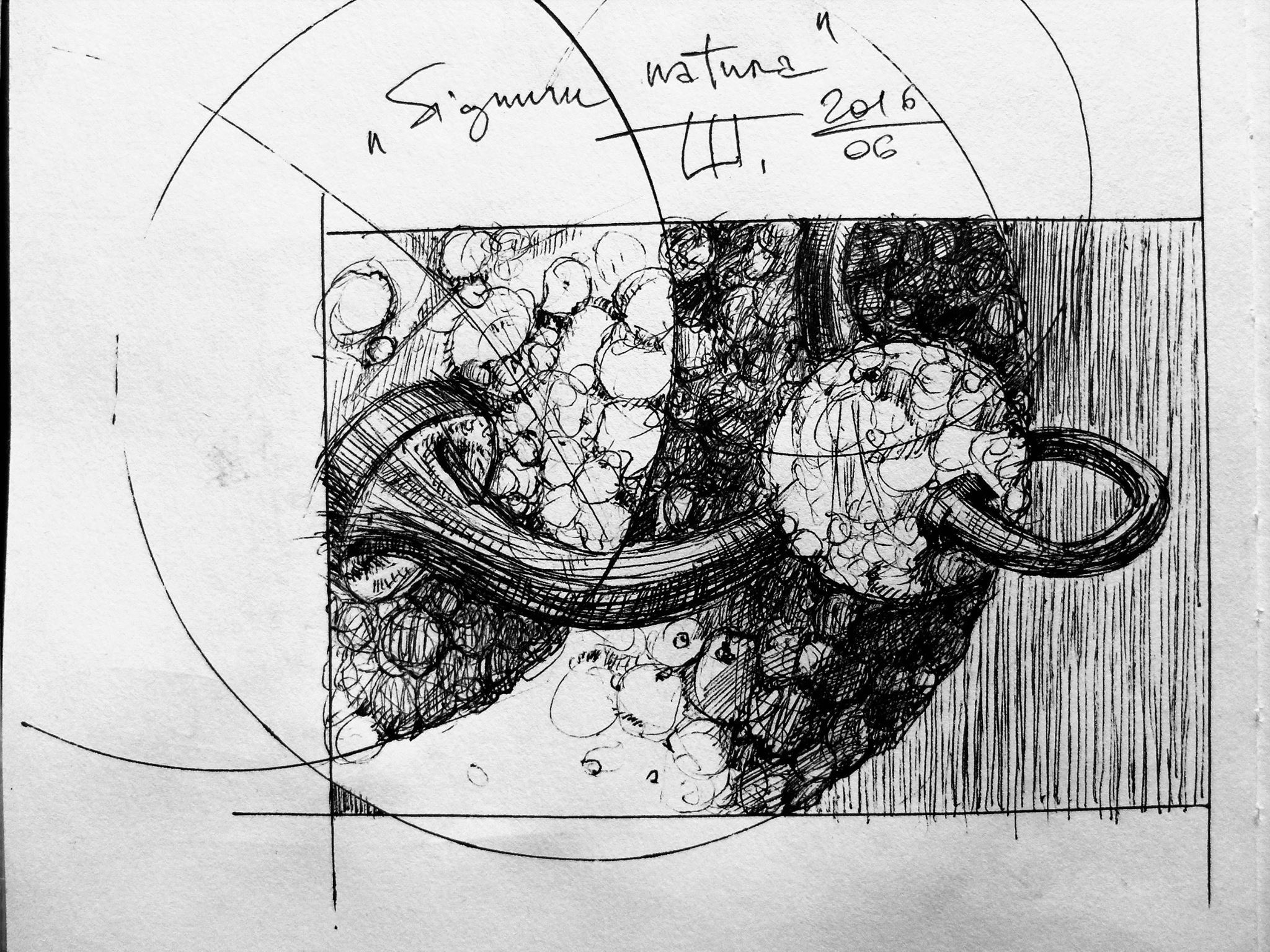
…a person gets immersed in teaching, engaging by offering guidance or corrections from the position of an older colleague […] It’s truly an interconnected world, full of positive surprises on both sides of the fence.
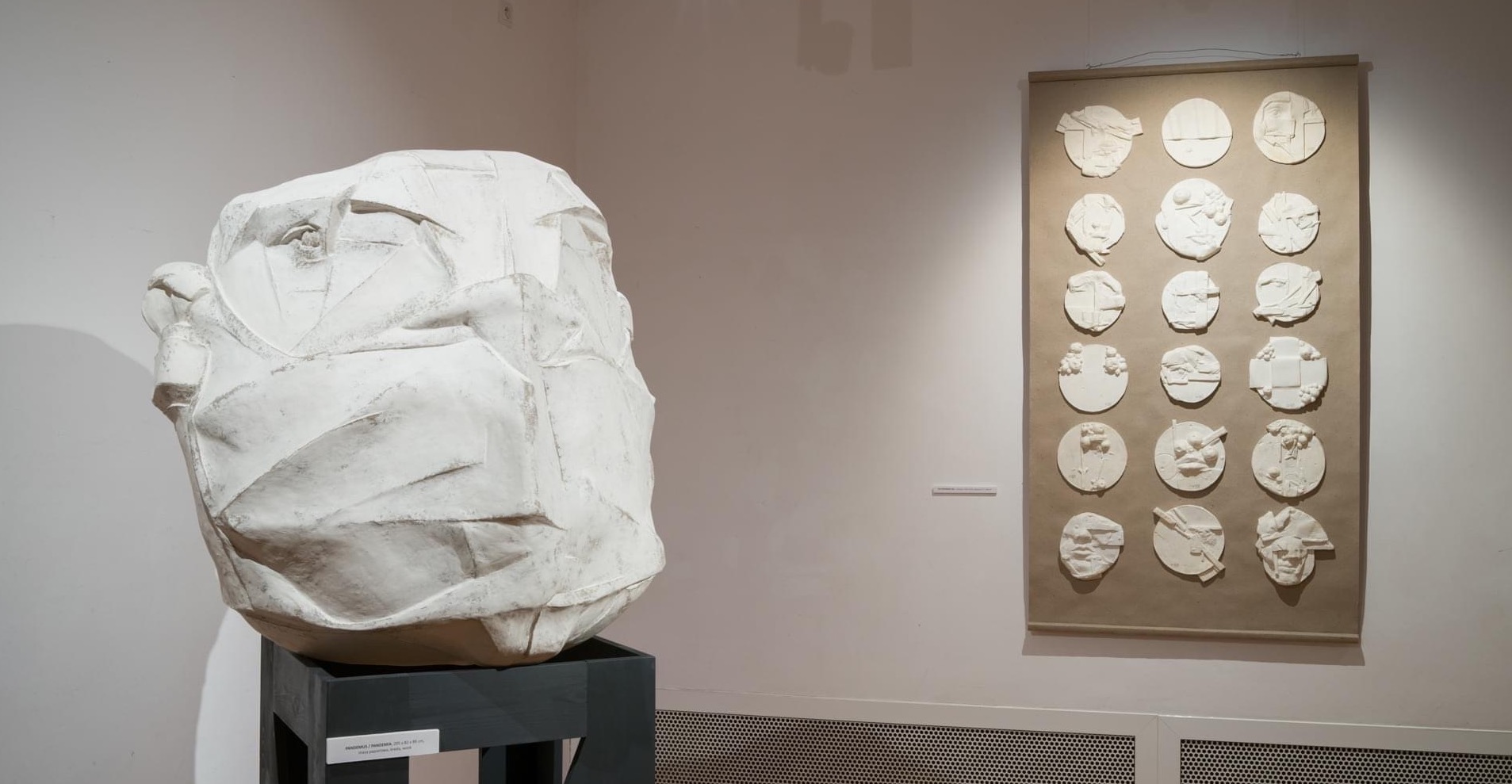
You also fulfill a role as the curator of the Art Gallery Strefa – the gallery of the Faculty of Interior Architecture. This is a completely different experience and another one of your successes. When you started, did you anticipate that it would turn out to be something so interesting? The gallery has a full exhibition schedule – what is the key to selecting the invited artists? What is the secret behind its popularity?
Thank you for evaluating my work as the curator of the Strefa Art Gallery at WAW as a success. It’s not for me to judge in such a way... time will show, and the exhibitions and their preparation will be evaluated as a successful exhibition or problem-solving venture. I’ll return to the words of Professor Wejman I quoted earlier – one must always rely on intuition, on the combination of knowledge and experience, which allows us to select an artist due to... well, personal aesthetic preferences. In these preferences, I find great help in proposing something and convincing the artist to showcase works that appeal to me (and I always provide an explanation for this). Above all, it’s because it’s the Strefa Art Gallery, which plays an educational role for our students and others. It points to techniques and solutions, works that may inspire them and, in the future, give them the confidence to propose their own solutions. The Faculty of Interior Architecture is an important part of the Academy of Fine Arts in Kraków, and our students cannot forget about the activities related to pure art – they must develop in this direction, and the gallery’s activity is meant to facilitate that. Our common language of communication is hand-drawn sketches, which are an autonomous part of communication in art and design, which is why I often ask artists to reveal their artistic process in creating a fragment or the whole of their work. They shouldn’t hesitate to show their sketches or rough drafts. This is why we have multimedia presentations accompanying the exhibition, which complement the overall display. It’s not always easy, but usually, it works out, and I am very grateful to the invited artists. In turn, they often thank us afterward for encouraging them to show their work in this way. I’d also like to mention the help and work of my colleagues, without whom the exhibitions in a given academic year wouldn’t have had the dimensions we were hoping for. The conclusion will be the release of a catalog/yearbook, which we will soon be able to enjoy together. :)
Tell us about your recent exhibitions.
This is not easy for me, because they have already taken place... time blurs the memory, and one exhibition automatically flows into another. I try not to show the same sculptures every time. I change their set depending on the space... I try to adapt to the interior and the potential message of the whole presentation. One exhibition that particularly stands out in my memory (for special reasons) is my solo exhibition at BWA in Rzeszów in 2021. I titled it OCCURSUM / MEETING, because it was an opportunity to present a very large-scale exhibition, showcasing works in cellulose, in paper pulp dyed in the pulp, and in terracotta. The last part of the exhibition was a display of my works in ceramic clay. One might conclude that it was a retrospective show. In fact, it was specifically organized for a meeting with friends I hadn’t seen in 30 years.
Unfortunately, the opening did not take place in person, because the Covid-19 pandemic and the related restrictions tightened again, and we couldn’t meet. Well, sometimes it happens that we can’t achieve our goals due to reasons beyond our control. Luckily, a live online stream took place, and everyone could watch it, and later, during the exhibition, individual visitors could see it in person and receive the exhibition catalog.
There were also other exhibitions earlier, but we most often think about those that are ahead of us, as new challenges.
What are you working on now? :)
You hit the nail on the head with that question . Currently, I am working on a series of new works with thematic cycles. The first consists of 15 relief works, each 40 x 40 cm, under the common title RESISTENTIA / RESISTANCE. They are numbered, and in addition to the individual numbers, they differ in their composition, all addressing the same theme. Among them, I’ve chosen to solve a larger-scale piece measuring 91 x 91 cm, which is likely a prelude to attempting more solutions on an even larger scale.
The next cycle, or rather a triptych, consists of works titled LAPIS ARBORES / STONE TREES, each around 80 cm in the diameter of the oval.
The final attempt and solution are compositions in the same 40 x 40 cm format, dedicated to Dante’s Divine Comedy, specifically the part titled Inferno. I can’t specify the number of works in this cycle just yet, but there will probably be five.
It’s hard to write about it since the works are ongoing, but they will definitely be featured in the upcoming exhibition at the Gallery in Przyziemie in Krakow, and part of them will be completed at the aforementioned Re-Medium. Terra workshop in Duszniki-Zdrój this September. Keep your fingers crossed for success in completing them.
I wish you continued success and fruitful work. Thank you for the conversation.
I won't thank you... to avoid jinxing it! :)
But I'm grateful for the conversation and the opportunity to present myself, even in this capacity, as it often means a lot to us! Thank you for the conversation.
title photo: Installation of the exhibition entitled. OCCURSUM / SPOTKANIE in BWA - Rzeszów, 2021
